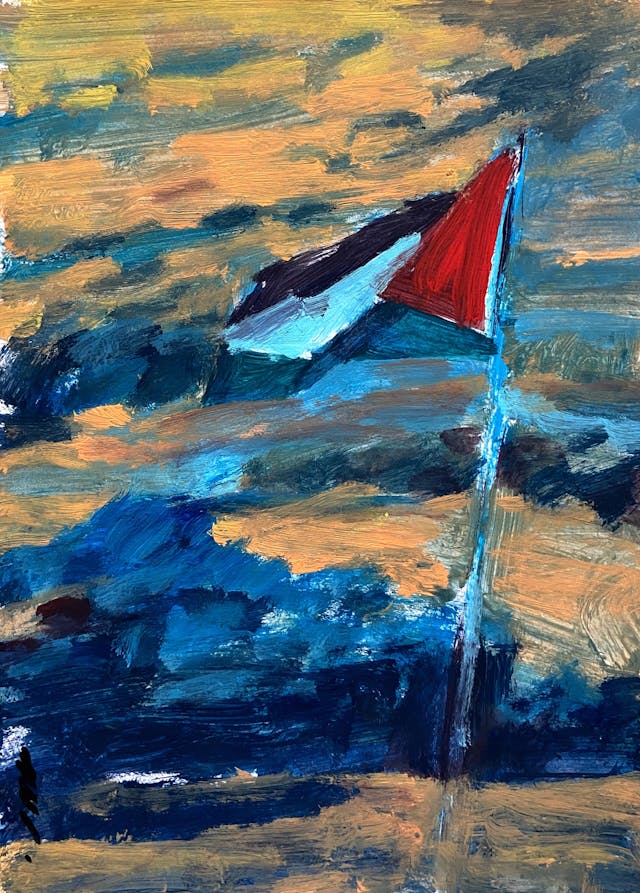
- Writing Gaza
Writing Gaza
Omar Berrada & Shivangi Mariam Raj
Elisa Adami finds in Palestine’s ancestral water cultures a source of life-affirming resistance against the ecocide in Gaza.
Do you think the water will forget what we have done, what we continue to do?
– Natalie Diaz, ‘The First Water Is the Body’ (2021)
Since the beginning of the war on Gaza and the ongoing genocide, Israel has denied Palestinians access to basic life necessities: electricity, fuel, medical supplies, food, and, crucially, water. The currently unfolding human-made famine that the besieged population is subject to is compounded by a policy of deliberate deprivation of water.1This is no accident of war but part of a systematic plan to eradicate any possibility of life in the Strip – for, as the protestors at Standing Rock reminded us, ‘Mní wičhóni’ or ‘Water is life’.2
The facts on the ground are stark and relentless. Early in the war, Israel spectacularly turned off the three pipelines that connect the Strip to the Israeli state-owned water company Mekorot. This already paltry water provision has never been restored in full, while the distribution network has been severely damaged in Israeli airstrikes.3 In 24 months of Israeli bombardment and ground operations, more than 80 percent of the territory’s water infrastructure has been systematically targeted and damaged.4 The coastal aquifer, Gaza’s only freshwater resource, requires desalination treatment, being naturally brackish and far exceeding salinity standards for potable water. Yet the only functioning desalination plant left – along with the few still working water pumps, waste disposal, and sewage treatment facilities – cannot operate without fuel and electricity, whose entry into the enclave has been largely restricted when not completely shut off. The ongoing near-total blockade of humanitarian aid since March 2025 continues to obstruct the import of critical water treatment items, forcing hundreds of thousands of people to drink unsafe water, either extracted from the ground or the coastal aquifer.5
Water, in all its forms, is polluted; from bearer of life, it has been turned into a carrier of disease and weapon of war. In early 2024, reports were confirmed that the Israeli army had flooded a network of underground tunnels with large volumes of seawater.6 Inevitably seeping into Gaza’s aquifer, seawater makes freshwater undrinkable and devastates arable lands, rendering them unfit for agriculture.7 Soil and groundwater have been contaminated by munitions and toxins as well as the hazardous materials released by collapsed buildings and the decomposing bodies of unrecovered victims. The atmosphere is choked with smoke, particulate matter, and a layer of toxic chemicals; the sea clogged with untreated waste and raw sewage.8
The calculated destruction of the water infrastructure in Gaza – only one facet of the multiple linked crises precipitated by Israel’s genocidal war – is causing severe, widespread, long-term, and irreversible damage to the natural environment, endangering even further what is already one of the most climate-vulnerable regions in our polluted and warming world. Genocide and ecocide are two faces of the same coin.9
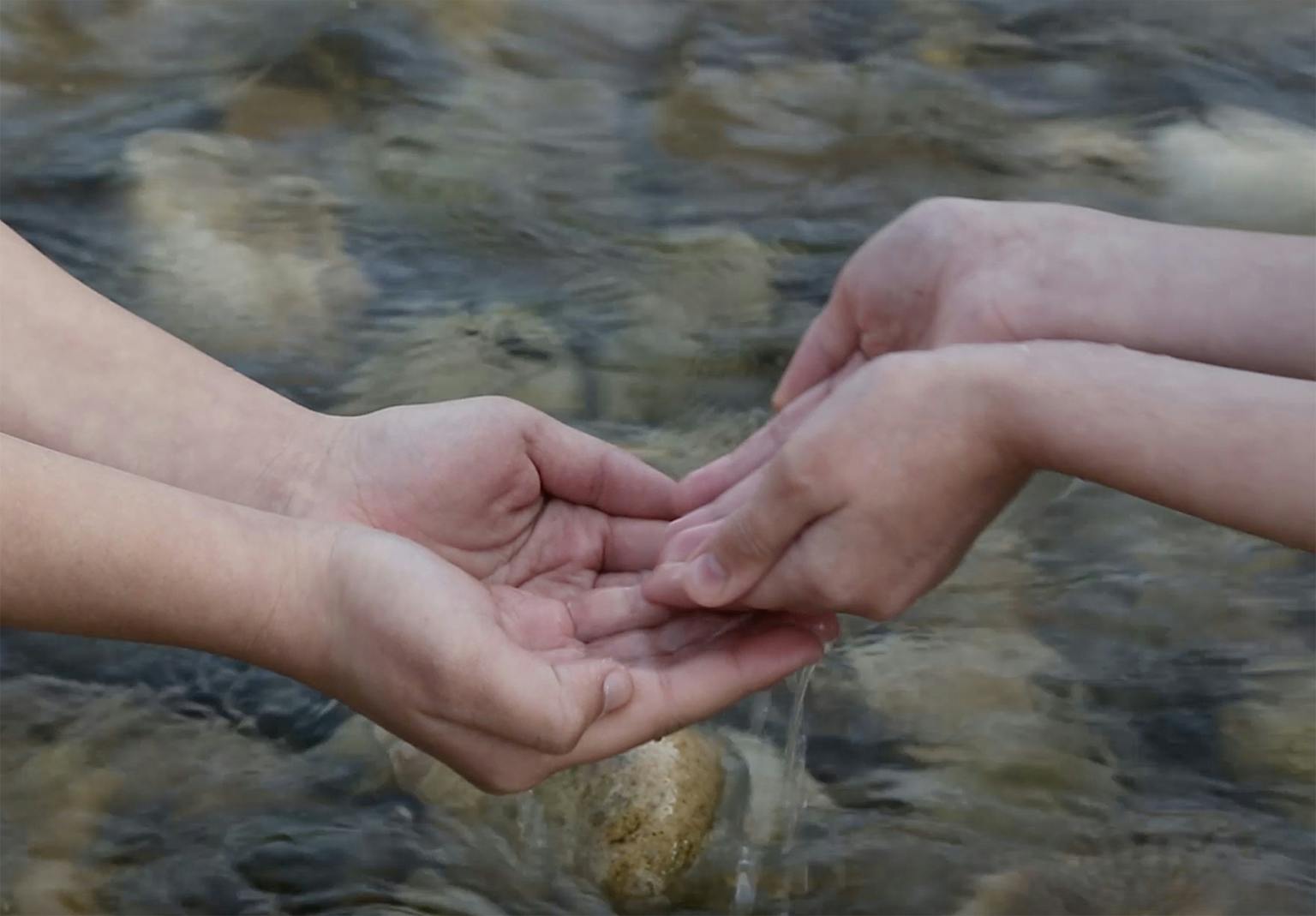
Jumana Emil Abboud, I Feel Everything (2022), video still. Courtesy of the artist. Photo: Issa Freij.
Nibi [water] always create more possibilities … to propel a continuous, global rebirth of life.
– Leanne Betasamosake Simpson, Theory of Water (2025)
Amid this horrific devastation and the despair induced by political inaction and the seeming futility of civil society mobilisation, I found refuge and a glimmer of something resembling hope in the words of Michi Saagiig Nishnaabeg writer Leanne Betasamosake Simpson. In her latest book, Theory of Water (2025), Simpson finds in the liquid element that binds our planet together a mentor and exemplar that can teach us a political theory and praxis of internationalism. Water flows across all kinds of borders, leaks from human-made containers, connects different places and organisms, cycles through different states of being, and always brings forth more life. It is through ‘its continual movement and cycling, its immense relationship with all forms of life on the planet’ that water defies and resists colonial-capitalist regimes of incarceration and control, reinventing possibilities for life out of their deadly coils.10
Simpson considers how the ongoing territorial dispossessions that settler colonialism has forced upon Indigenous peoples worldwide have led them to organise around land. While Indigenous peoples continue to see water as an integral part of the land and a precious gift one must safeguard and protect, the land-based focus of their struggles and its filtering through imposed Western framings of sovereignty has made them lose sight of the specific teachings that water holds in and of itself.11 While the imaginary of the land has long been perverted by its remaking into private property, water, Simpson suggests, can still intimate ‘worlds beyond the ones we’ve inherited from colonialism and racial capitalism’.12
In the present moment, learning from water’s teachings is more urgent than ever. As Simpson writes:
The present moment – one of climate catastrophe, of ongoing genocide and Nakba in Gaza, Palestine, of genocides in Sudan and Congo – demands that we direct our dreams and actions towards making worlds that refuse capitalism and dispossession and the spectacular violences required to maintain them. The present moment demands that we figure out how to create and maintain robust constellations of co-resistance and provide material support for anticolonial movements locally and globally.13
Water shows us that we can simultaneously ‘ground ourselves intimately in land and place, and relate that grounding to other movements, geographies, cultures, and lands’.14 Constantly circulating between the different networks that make up our planetary webs of life – from vast oceanic bodies to the minute droplets carried by our breath – the hydrological cycle ‘teaches us that our thinking is most powerful when it can connect the intimate to the global and move between scales effortlessly’.15 In water’s cyclical capacity to recharge, in its resilience, its iterative and transformative power, we can find models to sustain and strengthen bonds of solidarity across time and communities in struggle.
If the necropolitics of colonialism and racial capitalism have turned the Mediterranean Sea into a graveyard and one of the world’s deadliest and most securitised borders, let us flood it with a global flotilla of solidarity vessels.16 If water is everywhere poisoned, polluted, privatised, harnessed through concrete channels, and choked with dams, let us remember the stories that taught us instead to respect, revere, and protect it as a common resource – a gift without which we cannot live.
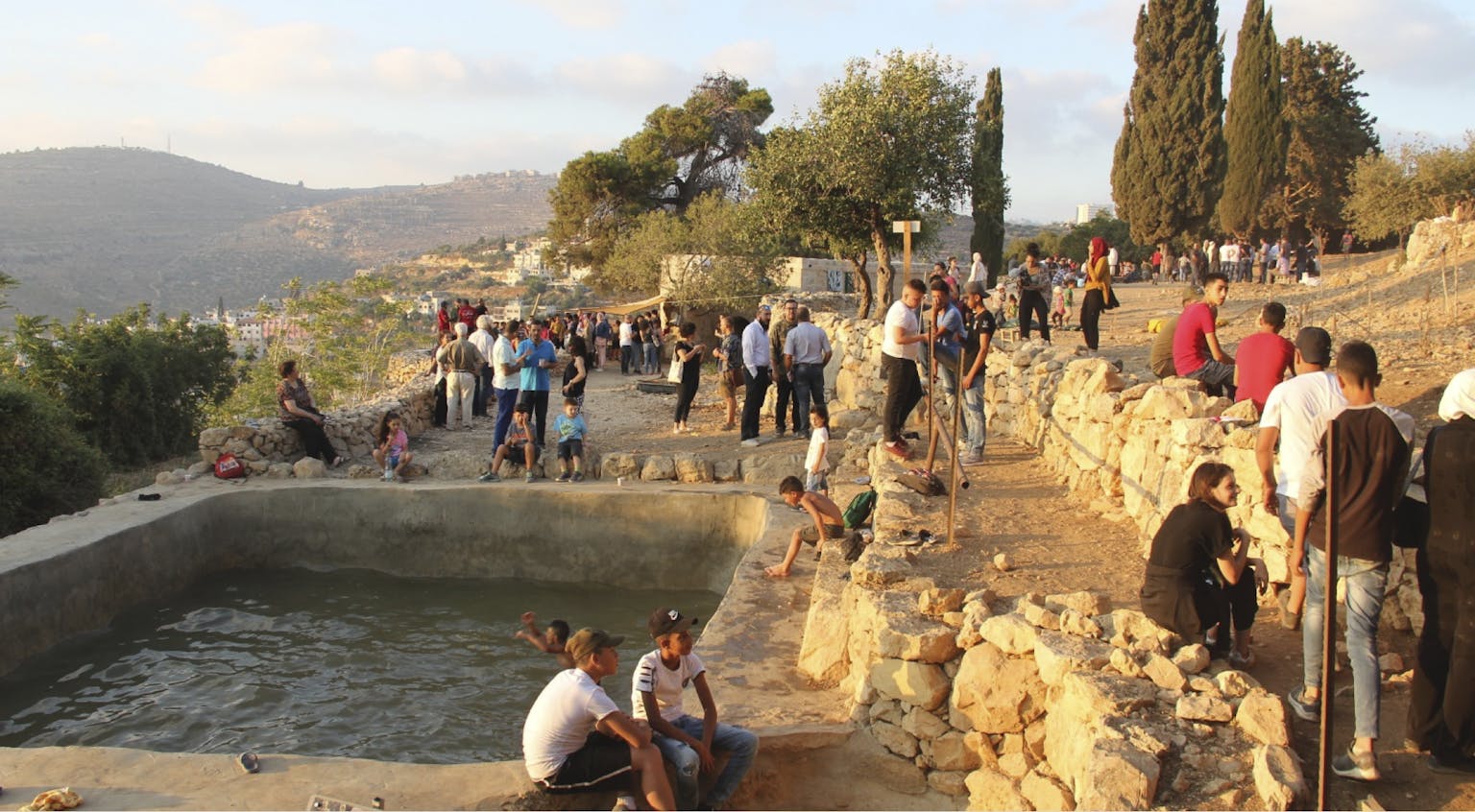
Um al Einein spring at Sakiya, Ein Qiniya, occupied West Bank, 2019. Courtesy of Nida Sinnokrot.
It is an old and widespread belief in all Semitic countries, that springs, cisterns and all running waters are inhabited.
– Tawfiq Canaan, ‘Haunted Springs and Water Demons in Palestine’ (1922)
Between the river and the sea are many springs, streams, and other water bodies.17 In the 1920s, the Palestinian physician and ethnographer of peasant culture Tawfiq Canaan set out to survey springs, wadis, wells, and cisterns in the valleys surrounding Jerusalem, Ramallah, and Bethlehem that were thought to be haunted by spirits. In his 1922 essay ‘Haunted Springs and Water Demons in Palestine’, published in Jerusalem, he inventoried 125 such springs along with the folktales surrounding them.18 A portal to a world on the verge of vanishing, Canaan’s text reveals an ‘enchanted’ landscape inhabited by all kinds of spirits and supernatural forces: jinn, ghouls, and marids as well as Christian and Muslim saints, and local sheikhs elevated to the status of divinity after their death.19 Sometimes, these spirits take the form of animals: sheep, hens, camels, mice, monkeys, or snakes. Others they appear as young brides combing their hair by the water spring.
Although Canaan proposed a sort of Manichean division between evil demons and good spirits, most of the jinn he encountered in these ancestral folktales are, unlike Judeo-Christian divinities, remarkably unpredictable. As Marina Warner explains, ‘They can perform miracles on behalf of men and women, protect them and punish wrongdoers on their behalf. The presiding spirits of holy places are … irritable, possessed of maleficent and benevolent powers, and consequently they need to be honoured and propitiated.’20 Interceding on behalf of humans, these fickle demigods are, as Salim Tamari explains, testament to the ‘persistence of pagan religiosity in Palestine, originating from pre-biblical times’.21
While some of the beguiling tales might seem puzzling in their ambiguity or inconsequential in their innocuousness, they nonetheless imbue the land with a sense of the sacred and the godly, inspiring devotion, awe, and at times even fear in the fellahin. They are a reminder that the land is also inhabited by more-than-human beings – animals, plants, and supernatural creatures – who one must respect and live in concert with. The spirited sites and their magical custodians act as mythical enforcers of what today we might think of as environmental protection laws, ensuring the safekeeping of the springs they stand guard over. Each folktale carries forward and makes it possible to hand down important local ecological knowledge pertaining to water protection. Taken together, they present an archive of sustainable practices of water management (limited or timed use of springs, seasonal adaptability, etc.), narrating – in story form – the strategies of resilience that are indispensable to those who inhabit arid lands and have learnt across generations how to preserve common resources.
In a fascinating study on Canaan, Tamari observes how the doctor’s extensive research into ancestral Palestinian culture and folk traditions was not just motivated by an antiquarian or ethnographic interest. It was crucially compelled by a political imperative to reject Zionist claims to the lands of historical Palestine that were founded on putative ancient roots and biblical sources. What Tamari terms Canaan’s ‘native ethnography’, with its embrace of syncretism and its emphasis on the longue durée of the local culture, sought to stress the ‘present day continuities between the biblical heritage (and occasionally pre-biblical roots) and Palestinian popular beliefs and practices’.22 The popular religion he documented was not dogmatically ‘Islamic, nor Christian nor Jewish, but a local magical adaptation of the sacred texts to the daily needs of the peasants’ – a practical and flexible manual that allowed them to confront fluctuating environmental and political circumstances.23
It is, perhaps, not an accident that these continuities manifest around water springs. In another context, that of Abdelrahman Munif’s 1984 petrofiction novel Cities of Salt, Rob Nixon notes how water and its dependent trees ‘underlay a culture of continuity-within-flux responsive to ecological vicissitudes’ and ‘infused with cosmological belonging’.24 Set in an unnamed Gulf country, Munif’s novel charts the uprooting of an ancestral local water-based culture and its forced displacement by an emerging petro-capitalist industry. Yet these newly built ‘cities of salt’, as Munif himself elaborates, ‘offer no sustainable existence. When the waters come in, the first waves will dissolve the salt and reduce these great glass cities to dust. In antiquity, as you know, many cities simply disappeared. It is possible to foresee the downfall of cities that are inhuman.’25
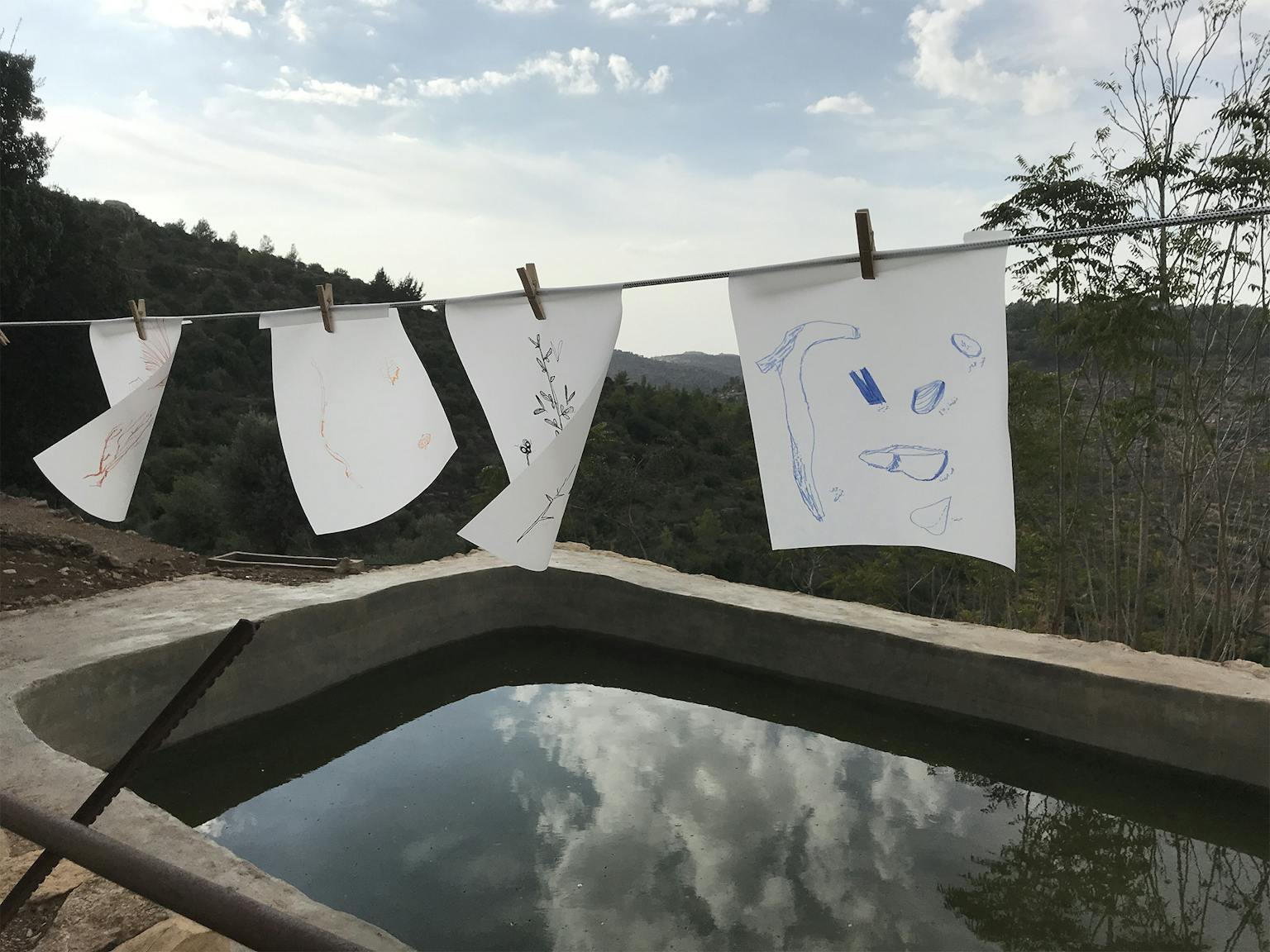
Jumana Emil Abboud, The Water Diviners workshop at Sakiya, Ein Qiniya (2021), occupied West Bank. Courtesy of the artist.
All water has a perfect memory and is forever trying to get back to where it was.
– Toni Morrison, talk at the New York Public Library (1986)
Since 2010, Palestinian artist Jumana Emil Abboud has embarked on her own ‘spirit’ search. Retracing Tawfiq Canaan’s steps about 100 years later, she soon discovered that many of the springs he had documented have disappeared from the landscape: some were dried up; others were sealed in concrete; most were off-limits, lying behind demarcation walls, military zones, and illegal Israeli settlements. Accompanied by cinematographer Issa Freij, Abboud located 20 of the sites listed by Canaan. These journeys, which the artist refers to as ‘hunts, trackings, mappings, or re-tracings’, were documented in writing, film, drawing, and performance.26 Apart from the sites confiscated by the Occupation, it became evident that the continuation of superstitious beliefs had secured the maintenance and upkeep of unseized holy places. In contrast, where disbelief had prevailed, the land and its watery treasures were neglected, abandoned, or overexploited.
In her meanderings through a battered and fragmented landscape, Abboud realised that Palestinians are not only denied access to the land and its water spots but are also exiled from its stories. They have been uprooted from their organic relationship with the natural world that once used to be mediated through the sacred and the numinous. Abboud’s practice can be seen as an attempt at re-enchanting the landscape by reconnecting the stories that used to be woven into it. Her most recent project, Water Diviners (2020–ongoing), is a collaborative exploration of water-lore through workshops, walks, and collective writing experiments. First developed in 2020 during a residency at Sakiya Art|Science|Agriculture, this body of work was initially inspired by seven endangered natural water sources in the village of Ein Qiniya, outside of Ramallah, where Sakiya is located. Water divination offers a metaphor for a practice of countermapping that seeks to find and reconnect with water through walks, rituals, and stories, both old and new.27
Artist Nida Sinnokrot, co-founder of Sakiya with Sahar Qawasmi, has also turned to mythical forms of water stewardship. His series of sculptures Water Witnesses (2020–ongoing) are formally inspired by the statues of Canaanite goddesses and the Palestinian amulets collected by Tawfiq Canaan. Composed of industrial parts from water management plants and found objects such as clay pots and water vessels, these totemic forms recall and reperform the sacred guardianship of water that is rooted in ancestral Palestinian heritage. These figures can be seen as the visible manifestation of the ‘invisible’ or ‘ephemeral infrastructure’ of spiritual presences who inhabit and watch over the land.28 For Sinnokrot, otherworldly beings and their associated mythologies are similar to infrastructures in that they govern and manage our relationship to nature and the built environment as well as ‘assuage our anxieties and offer forms of embodiment, collective labour, and celebration’.29 These sustainable mythologies, as he further elaborates, are a necessary complement to any sustainable technology; they are indispensable to ‘dismantle the visible and hidden infrastructures of occupation, racism, and patriarchy’ that dominate our lives.30
These are just two among many Palestinian artists and cultural workers who are reconnecting with their nation’s ancestral water culture.31 They do water’s memory-work: a ‘remembering’ what it used to be that, as Toni Morrison puts it, is also a ‘flooding’, washing away the oppressive and deadly infrastructures of the Occupation. For ‘memory, too’, as Alaa Alqaisi writes from Gaza amid pangs of hunger, ‘is a form of defiance’.32 Water’s deep memory and its ‘affective infrastructures’ remind us that there are other life-affirming worlds beyond the toxic and inhuman ones we have inherited from colonialism and racial capitalism.33
Learning from water’s slow movement and regenerative cycles, Simpson notes that ‘some revolts are incremental, eroding, melting, freezing, seeping, leaking’. Politics, human worlds, and solidarities that ‘are fractal, adaptive, non-linear and iterative, resilient and transformative, interdependent and decentralized, all move towards more possibilities for life’.34 We, too, wherever we are, can be part of this movement – a fractal, adaptive, and decentralised chain of solidarity with Palestine at its core.
In a 2016 performance script, Abboud wrote: ‘I live to see the slow and wicked demise … the dispossession of the vital life-giving organs of my home. Will I live to see a resurrection of sorts?’35 I end with her question that today rings more urgent and pressing than ever. Not only Palestine’s but the future of all of us hinges on the answer.
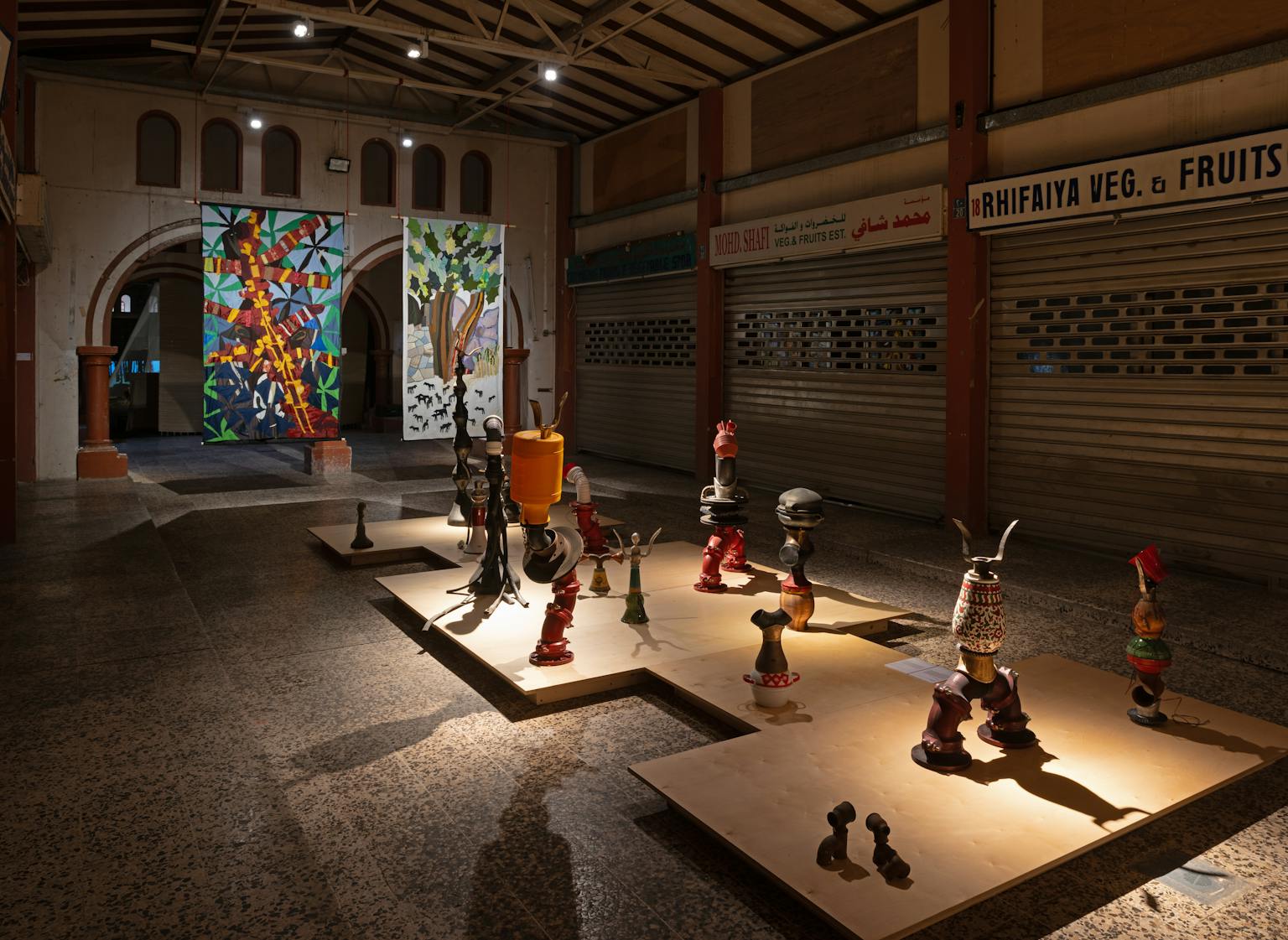
Sakiya, Water Witnesses (2020–ongoing), metal pipe fittings, bent pickaxes, clay vessels, found objects. Installation view: Sharjah Biennial 16, Old Jubail Vegetable Market, Sharjah, 2025. Courtesy of Sharjah Art Foundation. Photo: Shanavas Jamaluddin.

Omar Berrada & Shivangi Mariam Raj

Francesca Albanese

Youngsook Choi